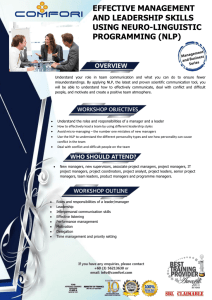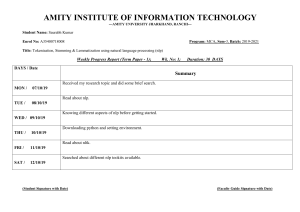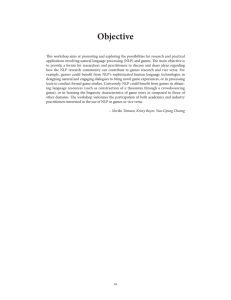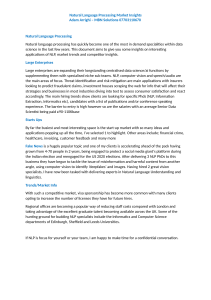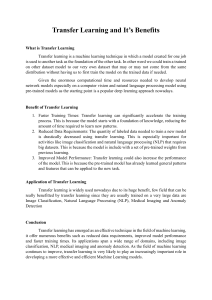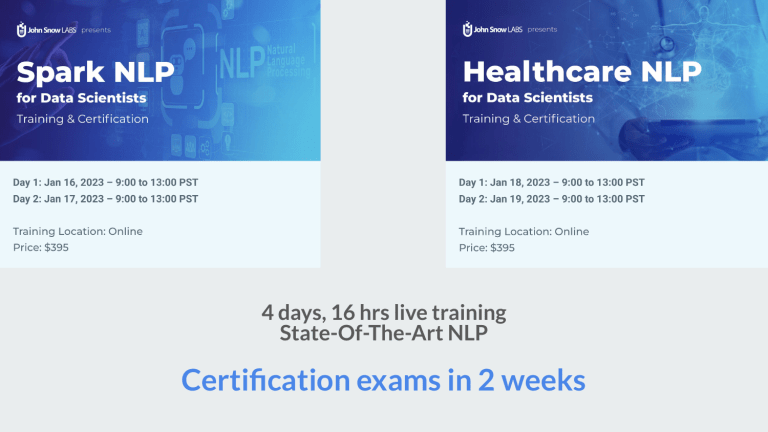
4 days, 16 hrs live training State-Of-The-Art NLP Certification exams in 2 weeks Spark NLP for Data Scientists Jan 16 & 17, 2023 Luca Martial lucas@johnsnowlabs.com Gursev Pirge gursev@johnsnowlabs.com David Amore Cecchini david@johnsnowlabs.com Christian Kasim Loan christian@johnsnowlabs.com Welcome - We have a lot of things ahead of us Day-1 50 min - 10 min Break 50 min - 10 min Break 50 min - Intro to John Snow Labs, Spark NLP and NLP Theory Spark NLP Pretrained Pipelines basics and JVM/Spark concepts Text Preprocessing and composing custom pipeline in Spark NLP Showcase of the 10000+ pretrained Models for 300+ languages in Spark NLP Break 50 min - Train Named Entity Recognizers (NER) and Classifier models Upload to Modelshub Welcome - We have a lot of things ahead of us Day-2 50 min - 10 min Break 50 min - 10 min Break 50 min - 10 min 50 min Token Classification with Transformers Sequence Classification with Transformers GPT2 - Conditional Text generation generate books, songs, marketing texts etc.. Spell Checking Unsupervised Keyword Extraction with YAKE Sentence Detection Graph triplet extraction Multilingual NLP - Train only on English data and predict for 100+ languages Question Answering, Summarization and other T5 applications Table Question Answering with TAPAS Image Classification with ViT Speech to Text with Wav2Vec2 Break - The Python NLU library basics, use any of the 7500+ models in 1 line of code NLP Server Session 1 (Day 1) ❖ NLP Theory and Introduction to John Snow Labs ❖ Pretrained Pipelines ❖ Spark, JVM and Spark NLP basic concepts ❖ Notebook 1 - Spark NLP Basics Spark NLP for Data Scientists https://nlp.johnsnowlabs.com/docs Resources CODE: - https://github.com/JohnSnowLabs/spark-nlp-works hop/blob/master/tutorials/Certification_Trainings/P ublic BOOKMARK: - https://nlp.johnsnowlabs.com/ - https://nlp.johnsnowlabs.com/docs/en/quickstart - https://nlp.johnsnowlabs.com/api/python/reference /index.html - spark-nlp.slack.com Introducing Spark NLP Spark NLP is an open-source natural language processing library, built on top of Apache Spark and Spark ML. (first release: July 2017) ○ A single unified solution for all your NLP needs ○ Take advantage of transfer learning and implementing the latest and greatest SOTA algorithms and models in NLP research ○ The most widely used NLP library in industry yrs in a row) ○ The most scalable, accurate and fastest library in NLP history ○ 111 total releases, every two weeks for the past 5 years (5 Spark NLP Modules (Enterprise and Public) Spark NLP in Industry Which of the following AI tools do you use? Which NLP libraries does your organization use? NLP Industry Survey by Gradient Flow, an independent data science research & insights company, September 2021 Peer-reviewed papers on Spark NLP NER Most Accurate in the Industry Spark NLP vs Commercial healthcare NLP Solutions Benchmark Introducing Spark NLP Introducing Spark NLP Spark is like a locomotive racing a bicycle. The bike will win if the load is light, it is quicker to accelerate and more agile, but with a heavy load the locomotive might take a while to get up to speed, but it’s going to be faster in the end. Faster inference LightPipelines are Spark ML pipelines converted into a single machine but multithreaded task, becoming more than 10x times faster for smaller amounts of data (small is relative, but 50k sentences is roughly a good maximum). Introducing Spark NLP Pipeline of annotators NLP Basics NLP Basics Tokenization ● First step in NLP pipelines, raw text is broken down into smaller, more manageable pieces. Without tokenization, NLP models would have to process the text as one large unit. ● Many other tokenization methods (character, sub-word, sentence). Pre-Processing NLP Basics ● The goal of both stemming and lemmatization is to reduce inflectional forms and sometimes derivationally related forms of a word to a common base form for normalization purposes. ● Lemmatization always returns real words, stemming doesn’t. Pre-Processing NLP Basics Stopword Removal ● For tasks like text classification, where the text is to be classified into different categories, stopwords are removed or excluded from the given text so that more focus can be given to those words which define the meaning of the text. Stopwords are considered insignificant in this case. Pre-Processing Spell Checking & Correction Pre-Processing Context Spell Checker Pre-Processing Normalization Pre-Processing N-gram Tokenization ● ● ● ● Kind of tokenizers which split words or sentences into several tokens Each token has certain number of words Number of words depends on the type of n-gram tokenizer Unigram, bigram, trigram, etc. Feature-Engineering Part Of Speech Tagging A POS tag (or part-of-speech tag) is a special label assigned to each token (word) in a text corpus to indicate the part of speech and often also other grammatical categories such as tense, number (plural/singular), case etc. Feature-Engineering & Classification Named Entity Recognition (NER) Feature-Engineering & Classification Dependency Parsing Feature-Engineering & Classification Session 1 (Day 1) - Coding Time ❖ Notebook 1 - Spark NLP Basics Spark NLP for Data Scientists Session 2 (Day 1) ❖ Text Preprocessing ❖ Composing Pipelines ❖ Working with Spark Dataframes ❖ Notebook 2 Text Preprocessing and composing Pipelines Spark NLP for Data Scientists Pipeline Structure Pipeline of annotators Session 2 (Day 1) - Coding Time ❖ Notebook 2 Text Preprocessing and composing Pipelines Spark NLP for Data Scientists Session 3 (Day 1) ❖ Usage and overview of the 10000+ pretrained models for 300+ languages ❖ Notebook 3 Spark NLP pretrained models Spark NLP for Data Scientists Spark NLP Modules (Enterprise and Public) Word & Sentence Embeddings ● ● ● Neural Networks and most other algorithms don’t work well with strings ○ Why not convert a string into a vector with numbers! ○ Semantically similar words vectors should be close in the vector space learned by the model ○ Dissimilar words are far from each other in vector space ○ Usually high dimensional, to give model more space to encode semantics Useful for many downstream tasks and commonly used in NLP Reduce dimensionality of the input space 34 Feature-Engineering Word & Sentence Embeddings ● ● ● Deep-Learning-based natural language processing systems encode words and sentences 📜 in fixed-length dense vectors 📐 to drastically improve the processing of textual data. Based on The Distributional Hypothesis: Words that occur in the same contexts tend to have similar meanings. Elmo and Bert-family embeddings are context-aware. 35 Feature-Engineering LSTM’s and RNN’s for Embeddings ● RNN : ○ ○ ○ ● Slow to train Not well parallelizable Vanishing/Exploding Gradients LSTM ○ ○ ○ Fixes vanishing/exploding gradient not scalable No transfer learning Feature-Engineering Transformers - Attention is All you Need - Visualized A highlighly parallelizable NN Architecture for Sequential Data Attention is All You Need https://ai.googleblog.com/2017/08/transformer-novel-neuralnetwork.html Feature-Engineering Transformers - Attention is All you Need - Why they rock A highlighly parallelizable NN Architecture for Sequential Data Feature-Engineering /home/ckl/Pictures/figma_nlu/transformerspng Search them all in the Modelshub https://nlp.johnsnowlabs.com/models Embeddings in Spark NLP Part 1 Search them all in the Modelshub https://nlp.johnsnowlabs.com/models Embeddings in Spark NLP Part 2 Search them all in the Modelshub https://nlp.johnsnowlabs.com/models Embeddings in Spark NLP Part 3 Search them all in the Modelshub https://nlp.johnsnowlabs.com/models Embeddings in Spark NLP Part 4 Search them all in the Modelshub https://nlp.johnsnowlabs.com/models Embeddings in Spark NLP Part 5 Search them all in the Modelshub https://nlp.johnsnowlabs.com/models Transformer Sequence Classifiers in Spark NLP Search them all in the Modelshub https://nlp.johnsnowlabs.com/models Transformer Token Classifiers in Spark NLP Part 1 Search them all in the Modelshub https://nlp.johnsnowlabs.com/models Transformer Question Answering in Spark NLP Part 1 Search them all in the Modelshub https://nlp.johnsnowlabs.com/models Transformer Question Answering in Spark NLP Part 2 Search them all in the Modelshub https://nlp.johnsnowlabs.com/models Transformer Question Answering in Spark NLP Part 3 Search them all in the Modelshub https://nlp.johnsnowlabs.com/models Transformer Question Answering in Spark NLP Part 4 Search them all in the Modelshub https://nlp.johnsnowlabs.com/models Transformers & Embeddings BERT is a bi-directional transformer for pre-training over a lot of unlabeled textual data to learn a language representation that can be used to fine-tune for specific machine learning tasks. While BERT outperformed the NLP state-of-the-art on several challenging tasks, its performance improvement could be attributed to the bidirectional transformer, novel pre-training tasks of Masked Language Model and Next Structure Prediction along with a lot of data and Google’s compute power. It is an Auto Encoder Language Model. XLNet is a large bidirectional transformer that uses improved training methodology, larger data and more computational power to achieve better than BERT prediction metrics on 20 language tasks. To improve the training, XLNet introduces permutation language modeling, where all tokens are predicted but in random order. This is in contrast to BERT’s masked language model where only the masked (15%) tokens are predicted. It is an Autoregressive Language Model. Albert is Google’s new “ALBERT” language model and achieved state-of-the-art results on three popular benchmark tests for natural language understanding (NLU): GLUE, RACE, and SQuAD 2.0. ALBERT is a “lite” version of Google’s 2018 NLU pre training method BERT. Researchers introduced two parameter-reduction techniques in ALBERT to lower memory consumption and increase training speed and the Next Sentence Prediction task is replace by Sentence Order Prediction USE (Universal Sentence Encoder) is a Transformer-based model for encoding sentences into embedding vectors that specifically target transfer learning to other NLP tasks and outperforms previous word-embedding models on various NLP tasks Transformers & Embeddings DistilBert is a compressed version of BERT, which leverages knowledge distillation during the pre-training phase and shows that it is possible to reduce the size of a BERT model by 40%, while retaining 97% of its language understanding capabilities and being 60% faster. It introduces a triple loss combining language modeling, distillation and cosine-distance losses. The smaller, faster and lighter model is cheaper to pre-train and we demonstrate its capabilities for on-device computations in a proof-of-concept experiment and a comparative on-device RoBerta is a optimized version of BERT, which has improved hyperparameters and training data size. The findings show that the original BERT was significantly undertrained and with (1) Longer training, bigger batches, (2) removing next sentence prediction objective, (3) training on longer sequences and (4) dynamically changing the masking pattern applied to the training data every previous BERT can be outperformed and new state of the art can be achieved XlmRoBerta is a multilingual BERT model which significantly outperforms multilingual BERT on a variety of cross-lingual benchmark and large accuracy gains on various multi-lingual benchmarks for 88 languages that appear in the Wiki-100 corpus Longformer is a Transformer-based model which improves on processing long sequences by introduces a windowed attention mechanism and a linearly scaling self-attention mechanism which scales linearly with sequence length and easily processes documents with thousands or more tokens. ● ● ● ● ● ● ● ● ● ● ● ● ● ● ● ● ● ● ● ● ● ● ● ● ● ● ● ● NLP Transformers & Embeddings BERT : https://arxiv.org/abs/1810.04805 XLNet : https://arxiv.org/abs/1906.08237 Albert : https://arxiv.org/abs/1909.11942 Elmo : https://arxiv.org/abs/1802.05365 USE : https://arxiv.org/abs/1803.11175 DistilBert : https://arxiv.org/abs/1910.01108 RoBerta : https://arxiv.org/abs/1907.11692 DeBerta : https://arxiv.org/abs/2006.03654 XlmRoberta : https://arxiv.org/abs/1911.02116 Longformer : https://arxiv.org/abs/2004.05150 Electra : https://arxiv.org/abs/2003.10555 T5 : https://arxiv.org/abs/1910.10683 Marian: https://arxiv.org/abs/1804.00344 GPT2: https://openai.com/blog/better-language-models/ SpanBERT https://arxiv.org/abs/1907.10529 CamemBERT https://camembert-model.fr/ SciBert https://www.aclweb.org/anthology/D19-1371/ MiniLm https://arxiv.org/abs/2002.10957 CovidBERT https://arxiv.org/abs/2005.07503 BioBERT https://arxiv.org/abs/1901.08746 indoBERT https://arxiv.org/abs/2011.00677 MuRIL https://arxiv.org/abs/2103.10730 sapBERT https://github.com/cambridgeltl/sapbert BioFormer https://github.com/WGLab/Bioformer LinkBERT https://arxiv.org/abs/2203.15827 MacBERT https://aclanthology.org/2020.findings-emnlp.58 DOC2Vec : https://arxiv.org/abs/1301.3781 Word2Vec: https://arxiv.org/abs/1301.3781 100+ Languages supported by Language-agnostic BERT Sentence Embedding (LABSE) and XLM-RoBERTa Train in 1 Language, predict in 100+ different languages Translate between 200+ Languages With Marian: Fast Neural Machine Translation in C++ Exploring the Limits of Transfer Learning with a Unified Text-to-Text Transformer 1. 2. 3. 4. 5. 6. 7. 8. Text summarization Question answering Translation Sentiment analysis Natural Language inference Coreference resolution Sentence Completion Word sense disambiguation Train Transformer Models via Huggingface or TfHub and scale with Spark NLP https://nlp.johnsnowlabs.com/docs/en/transformers#example-notebooks Session 3 (Day 1) - Coding Time ❖ Notebook 3 Spark NLP pretrained models Spark NLP for Data Scientists Session 4 (Day 1) ❖ Training a Named Entity Recognizer ❖ Training a Deep Learning classifier ❖ Upload/Download your own model via John Snow Labs Models Hub Spark NLP for Data Scientists Session 4 (Day 1) ❖ Notebook 4 NERDL Training ❖ Notebook 5 ClassifierDL, SentimentDL, MultiClassifierDL Training ❖ Upload a Trained Model to JSL Models Hub Spark NLP for Data Scientists NER-DL in Spark NLP The best NER score in production 93.3 % Test Set Bert NerDLApproach NER-DL in Spark NLP NER Systems 1. Classical Approaches (rule based) 2. ML Approaches - Multi-class classification - Conditional Random Field (CRF) 3. DL Approaches - Bidirectional LSTM-CRF - Bidirectional LSTM-CNNs - Bidirectional LSTM-CNNS-CRF - Pre-trained language models (Bert, Elmo) 4. Hybrid Approaches (DL + ML) NER-DL in Spark NLP Char-CNN-BiLSTM NER-DL in Spark NLP Char-CNN-BiLSTM NER-DL in Spark NLP CoNNL2003 format BIO schema John Smith ⇒ PERSON New York ⇒ LOCATION * Each line contains four fields: the word, its part-of-speech tag, its chunk tag and its named entity tag. * CoNLL: Conference on Computational Natural Language Learning Coding ... Open 4. NERDL Training notebook in Colab (click on Colab icon or open in a new tab) https://github.com/JohnSnowLabs/spark-nlp-worksho p/blob/master/tutorials/Certification_Trainings/Public/ 4.NERDL_Training.ipynb SentimentDL, ClassifierDL, and MultiClassifierDL ● BERT ● Small BERT ● 100 dimensions ● BioBERT ● 200 ● CovidBERT ● LaBSE ● ALBERT ● ELECTRA ● XLNet ● ELMO ● Universal Sentence ● 2 classes (positive/negative) ● 3 classes (0, 1, 2) ● 4 classes (Sports, Business, etc.) ● 5 classes (1.0, 2.0, 3.0, 4.0, 5.0) ● ... 100 classes! dimensions ● 128 dimensions ● 256 dimensions ● 300 dimensions ● 512 dimensions ● 768 Encoder ● GloVe dimensions ● 1024 dimensions ● tfhub_ues ● tfhub_use_lg ● glove_6B_100 ● glove_6B_300 ● glove_840B_300 ● bert_base_cased ● bert_base_uncased ● bert_large_cased ● bert_large_uncased ● bert_multi_uncased ● electra_small_uncased ● elmo ● ... 100+ Word & Sentence models Classifier DL Tensorflow Architecture Upload trained models to Models Hub ● Trained models can be uploaded and shared via the modelshub ● Zip and Download the model ● Go to https://modelshub.johnsnowlabs.com/ and upload zip file Session 4 (Day 1) - Coding Time ❖ Notebook 4 NERDL Training ❖ Notebook 5 ClassifierDL, SentimentDL, MultiClassifierDL Training ❖ Upload your own model via John Snow Labs Models Hub Spark NLP for Data Scientists End of Day 1 - see you tomorrow! Same time, same place :) Spark NLP for Data Scientists Welcome to Day-2 - We have a lot of things ahead of us Day-2 50 min - 10 min Break 50 min - 10 min Break 50 min - 10 min 50 min Sequence Classification with Transformers Token Classification with Transformers Text Style Transfer and SQL code generation from Natural Language Text with T5 GPT2 - Conditional Text generation generate books, songs, marketing texts etc.. Spell Checking Sentence Detection Unsupervised Keyword Extraction with YAKE Graph triplet extraction Question Answering, Summarization and other T5 applications Image Classification with ViT Speech to Text with Wav2Vec2 Table Question Answering with TAPAS Multilingual NLP - Train only on English data and predict for 100+ languages Break - The Python NLU library basics, use any of the 7500+ models in 1 line of code NLU & Streamlit NLP Server NLU OCR Session 1 (Day 2) ❖ Sequence Classification with Transformer Models ❖ Token Classification with Transformer Models ❖ GPT2 - Conditional Text Generation ❖ Generate SQL from natural language text and Text Style Transfer with T5 ❖ Notebook 5.3 Transformers for Sequence Classification ❖ Notebook 14 Transformers for Token Classification ❖ Notebook 16 Text Generation with GPT2 Spark NLP for Data Scientists Where is Text Generation used in the Industry? ● Natural Language Generation (NLG) is a sub-field of natural language processing (NLP) ○ ● Automatically generate coherent and useful text for human consumption NLG Systems in use ○ ○ ○ ○ Google Translate Dialogue Systems (Siri, Alexa, Cortana, Google Home, Bigsby) Summarizers (Google Search Results) ■ Emails, News, Papers, Reports, Conversations Creative writing ■ Stories, Poetry, Narratives ■ Fake News, Botnets What is a Language Model? How does a Language Model generate text? How does a Language Model generate Text? What are some Sampling Algorithms and Parameters ? ● ● Parameters: ○ Repetition Penalty: Penalize generation candidates based on how often they already exist based See CTRL ○ Max Repeated NGrams: Block some NGrams to occur more than K times ○ Temperature: Reshape distribution given by Softmax ○ Min/Max Output Length: Limit the length of generated Sampling Algorithms: ○ ArgMax based : Pick word with highest probability of occurring next, Greedy Algorithm. ■ Makes generation deterministic, i.e. always generates the same text for the same prompt ○ Top-K Sampling: choose from Top-K highest probability words in distribution ○ Top-P Sampling: choose from words with summed probability equal or greater than P What's the difference between Top-P and Top-K Sampling? ● ● ● ● ● Higher K and P: makes choices more diverse and risky. Less logical and coherent Lower K and P: makes choices more generic and safe Also more logical and coherent Softmax normalizes logits between 0 and 1. We can tweak the function with the T parameter High T: Make Distribution more uniform and diverse. Associated with creativity and randomness of generations. Low T: Make Distribution concentrate around top words, more spiky and less diverse. Associated with more logical and coherent generations. What is Prompt Engineering? Session 1 (Day 2) - Coding Time ❖ Notebook 5.3 Transformers for Sequence Classification ❖ Notebook 14 Transformers for Token Classification ❖ Notebook 16 Text Generation with GPT2 Spark NLP for Data Scientists Session 2 (Day 2) ❖ Notebook 7 Context Spell Checker ❖ Notebook 8 YAKE ❖ Notebook 9 Sentence Detection ❖ Notebook 12 RDF Graph Extraction Spark NLP for Data Scientists Spell Checking & Correction Context Spell Checker Notebook 7 Spell Checker Unsupervised Keyword Extraction YAKE! Is Yet Another Keyword Extraction Algorithm that can extract keywords without any weight by leveraging statistical properties of ngrams Notebook 8 YAKE Contextual Aware DL Sentence Detector Notebook 9 Sentence Detector DL Extract RDF Semantic Triplets Typed/Untyped Dependency Parsers define a Predicate Relationship between Subject and Object Notebook 12 Graph Extraction Session 2 (Day 2) - Coding Time ❖ Notebook 7 Context Spell Checker ❖ Notebook 8 YAKE ❖ Notebook 9 Sentence Detection ❖ Notebook 12 RDF Graph Extraction Spark NLP for Data Scientists Session 3 (Day 2) ❖ Notebook 5.2 Training Multilingual Classifier ❖ Notebook 10 Question Answering and Summarization and more with T5 ❖ Notebook 18 VIT for Image Classification ❖ Notebook 19 Speech2Text with Wav2Vec2 ❖ Notebook 17 Table Question Answering with TAPAS Spark NLP for Data Scientists 100+ Languages supported by Language-agnostic BERT Sentence Embedding (LABSE) and XLM-RoBERTa Train in 1 Language, predict in 100+ different languages Notebook 5.2 Training Multilingual Classifier Notebook 10 Question Answering and Summarization and more with T5 Exploring the Limits of Transfer Learning with a Unified Text-to-Text Transformer 1. 2. 3. 4. 5. 6. 7. 8. 9. 10. Text summarization Question answering Translation Generate SQL from natural language text Text style transfer Sentiment analysis Natural Language inference Coreference resolution Sentence Completion Word sense disambiguation TAPAS for Table Classification Notebook 17 Table Question Answering with TAPAS TAPAS models have been trained using a combination of three datasets: ● ● ● TAPAS: Weakly Supervised Table Parsing via Pre-training SQA, Sequential Question Answering by Microsoft (it was not trained to return aggregation operations as SUM, COUNT, etc - see below) WTQ, Wiki Table Questions by Stanford University (with aggregation operations) Wiki SQL, by Salesforce, also with aggregation operations. Table Classifiers Overview Image Classification with ViT Notebook 18 VIT for Image Classification Scale Vision Transformers (ViT) Beyond Hugging Face VIT: An Image is Worth 16x16 Words: Transformers for Image Recognition at Scale Over 200 VIT Models in various languages and sizes Speech to Text Wav2vec 2.0 Notebook 19 Speech2Text with Wav2Vec2 wav2vec 2.0: A Framework for Self-Supervised Learning of Speech Representations Over 2000 Wav2Vec Models in various languages and sizes Spark NLP Resources Spark NLP Official page Spark NLP Workshop Repo JSL Youtube channel JSL Blogs Introduction to Spark NLP: Foundations and Basic Components (Part-I) Introduction to: Spark NLP: Installation and Getting Started (Part-II) Named Entity Recognition with Bert in Spark NLP Text Classification in Spark NLP with Bert and Universal Sentence Encoders Spark NLP 101 : Document Assembler Spark NLP 101: LightPipeline https://www.oreilly.com/radar/one-simple-chart-who-is-interested-in-spark-nlp/ https://blog.dominodatalab.com/comparing-the-functionality-of-open-source-natural-language-processing-libraries/ https://databricks.com/blog/2017/10/19/introducing-natural-language-processing-library-apache-spark.html https://databricks.com/fr/session/apache-spark-nlp-extending-spark-ml-to-deliver-fast-scalable-unified-natural-language-processing https://medium.com/@saif1988/spark-nlp-walkthrough-powered-by-tensorflow-9965538663fd https://www.kdnuggets.com/2019/06/spark-nlp-getting-started-with-worlds-most-widely-used-nlp-library-enterprise.html https://www.forbes.com/sites/forbestechcouncil/2019/09/17/winning-in-health-care-ai-with-small-data/#1b2fc2555664 https://medium.com/hackernoon/mueller-report-for-nerds-spark-meets-nlp-with-tensorflow-and-bert-part-1-32490a8f8f12 https://www.analyticsindiamag.com/5-reasons-why-spark-nlp-is-the-most-widely-used-library-in-enterprises/ https://www.oreilly.com/ideas/comparing-production-grade-nlp-libraries-training-spark-nlp-and-spacy-pipelines https://www.oreilly.com/ideas/comparing-production-grade-nlp-libraries-accuracy-performance-and-scalability https://www.infoworld.com/article/3031690/analytics/why-you-should-use-spark-for-machine-learning.html Session 3 (Day 2) - Coding Time ❖ Notebook 5.2 training Multilingual Classifier ❖ Notebook 10 Question Answering and Summarization with T5 ❖ Notebook 18 VIT for Image Classification ❖ Notebook 19 Speech2Text with Wav2Vec2 ❖ Notebook 17 Table Question Answering with TAPAS Spark NLP for Data Scientists Session 4 (Day 2) ❖ Introduction to the Python NLU Library ❖ Introduction to NLP Server ❖ Notebook 13 - NLU Crash course, every Spark NLP model in 1 line Spark NLP for Data Scientists What is NLU? ● All of the 10000+ Spark NLP models in 1 line of code ● Recognize text in Images, PDFs, DOCX files in 1 line of code via NLU powered by Spark OCR ● Train models in 1 line of code ● Visualize with Streamlit or in Jupyter Notebook ● Automagically generates Spark NLP pipelines based on your request (Dependency Resolution) ● Works on Pandas/Spark/Modin Dataframes and returns same type of Dataframe NLU : Apache License 2.0 ● Tokenization ● BERT Embeddings ● Sentence Detector ● ELMO Embeddings ● Stop Words Removal ● ALBERT Embeddings ● Normalizer ● XLNet Embeddings ● Stemmer ● Universal Sentence Encoder ● Lemmatizer ● BERT Sentence Embeddings ● NGrams ● Sentence Embeddings ● Regex Matching ● Chunk Embeddings ● Text Matching ● Unsupervised keywords extraction ● Chunking ● Language Detection & Identification ● Date Matcher ● Multi-class Text Classification ● Part-of-speech tagging ● Multi-label Text Classification ● Dependency parsing ● Multi-class Sentiment Analysis ● Sentiment Detection (ML models) ● Named entity recognition ● Spell Checker (ML and DL models) ● Easy TensorFlow integration ● Word Embeddings ● Full integration with Spark ML functions ● +250 pre-trained models in 46 languages! ● +90 pre-trained pipelines in 13 languages! Visualize NER results Visualize Dependency Trees Visualize Assertion results Visualize Resolution Visualize Entity Relationships NLU Cheat Sheets Text Generating Sequence to Sequence Transformers in in NLU & Spark NLP Summarize, answer questions, generate SQL and more with Google’s T5 Showcased in this tutorial Webinar Generate long sequences of text, Augment Text and more with Open AI’s GPT2 Showcased today Translate between over 200 languages with Microsoft’s MarianNMT showcased on chinese in this tutorial webinar More NLU Ressources ● ● ● ● ● ● ● ● ● ● Join our Slack NLU Website NLU Github Many more NLU example tutorials Overview of every powerful nlu 1-liner Checkout the Modelshub for an overview of all models Checkout the NLU Namespace where you can find every model as a tabel Intro to NLU article In Depth and Easy Sentence Similarity Tutorial, with StackOverflow Questions using BERTology embeddings 1 line of Python code for BERT, ALBERT, ELMO, ELECTRA, XLNET, GLOVE, Part of Speech with NLU and t-SNE Webinars and Videos ● ● ● ● ● ● NLU & Streamlit Tutorial Crash course of the 50 + Medical Domains and the 200+ Healthcare models in NLU Multi Lingual NLU Webinar - Working with Chinese Text Data John Snow Labs NLU: Become a Data Science Superhero with One Line of Python code Python Web Def Conf - Python's NLU library: 4,000+ Models, 200+ Languages, State of the Art Accuracy, 1 Line of Code NYC/DC NLP Meetup with NLU Session 4 (Day 2) - Coding Time ❖ Notebook 13 - NLU Crash course, every Spark NLP model in 1 line Spark NLP for Data Scientists NLP Server - Powerful private deployable NLP Rest API https://nlp.johnsnowlabs.com/docs/en/nlp_server/nlp_server 4000+ Models in 200 languages available as API and GUI with a few clicks in the AWS marketplace. This enables you to use all of these Models with any programming Language by simple using REST API calls API Usage in 3 Steps : ● Query - Send Data request ● Poll - Is server done processing? ● Get result - Get result when server done Step 1 : Post a request ● Post a data processing request ● Returns UUID status Step 2 : Poll for result ● Poll Server for processing status Step 3 : Get result as JSON ● Get result for UUID ● Contains NLP predictions All of Spark NLP features behind a simple to use API. deployable in a few clicks on AWS - https://nlp.johnsnowlabs.com/docs/en/nlp_server/nlp_server - Youtube Tutorial for NLP Server Deployment on AWS Thank You!
